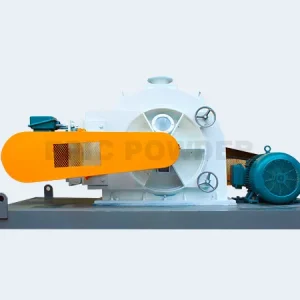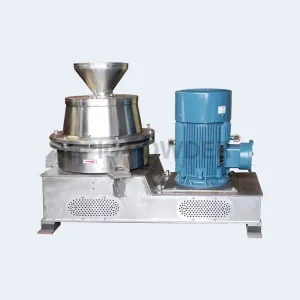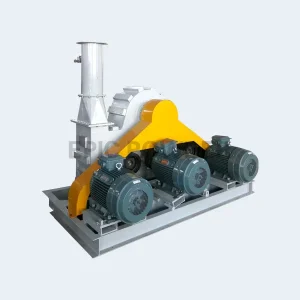In concrete, ultrafine powder, a key mineral admixture, helps. It improves the gradation of powder materials and the concrete’s performance. Ultrafine powder boosts concrete’s performance. It also saves energy and reduces emissions. On one hand, adding ultrafine powder can cut cement use. This reduces energy use and carbon emissions in concrete production. On the other hand, the reuse of ultrafine powder is also in line with the concept of circular economy. Many industrial wastes (like fly ash and slag) can be turned into treasures. After ultrafine grinding, they become high-value-added building materials. This reduces waste, saves raw materials, and promotes sustainability.
Cement voids and particle size range
The concrete grading system values the mix of coarse and fine aggregates. But, the gradation of powder is overlooked! Cement has a void ratio of about 50%. Its particle size varies widely, usually from a few to tens of microns. The wide particle size distribution creates many voids between the cement particles. These voids reduce the concrete’s compactness. They also harm its workability and durability. To solve this problem, we must mix ultrafine powder into concrete. Ultrafine powder has a particle size of less than 10 microns. It can fill the gaps between cement particles and improve concrete’s density.
The ultrafine powder reduces concrete’s porosity. It also improves its structure’s uniformity and stability. Also, ultra-fine powder can improve concrete’s fluidity. It makes it easier to work with and shape during construction. It also helps concrete resist environmental factors, making it more durable. , such as temperature changes, humidity, and chemical erosion, can maintain good performance. We can greatly improve concrete. We just need to control the cement particle size and use ultrafine powder. This will meet the high performance standards of modern construction.
Chemical characteristics of ultrafine powders participating in hydration reactions
Ultrafine powder has a very small size and a high surface area. This makes it very reactive. During concrete’s hydration, tiny particles can quickly react with the cement’s hydration products. This reaction generates more hydration products. These new hydration products fill the tiny gaps in the concrete. They also boost the concrete’s strength and durability. Also, ultrafine powder can greatly boost the cement’s hydration reaction. It speeds up the reaction and improves efficiency. This acceleration effect lets concrete gain strength faster. It shortens the construction period and cuts costs.
Ways and principles to stimulate the activity of ultrafine powder
To enhance the activity of ultrafine powder, we can use various excitation methods. These excitation methods include mechanical activation, chemical excitation, joint activation, and surface modification. Their combined use can greatly improve the activity of ultrafine powders. This makes them useful in industry, materials science, and medicine. Play a bigger role.
The technical measures for stimulating the activity of ultrafine powder mainly include the following:
Mechanical activation
This is a method to enhance the activity of ultrafine powder through physical means. Mechanical activation methods, like dry grinding, reduce particle size. Long-term grinding increases their surface area and energy. This method is an effective way to activate ultrafine powders, like fly ash. It can greatly improve their surface activity. This, in turn, enhances their performance in various applications.
Chemical stimulation
Chemical excitation means to boost the hydration of ultrafine powders. This is done by adding specific chemical stimulants. The key is to select suitable chemicals. They must promote the hydration reaction of ultrafine powders and increase their activity. However, chemical stimulants may have adverse effects on the material. They can affect its workability, volume stability, and durability. In practical use, we must tightly control and optimize chemical stimulants. We need to improve ultrafine powders’ activity without harming their performance.
Joint Activation
Combined activation is a method. It merges the benefits of mechanical activation and chemical excitation. This method first improves the grinding process. It achieves fine grinding of ultrafine powder. It reduces the particle size. It increases the surface area and energy. Then, a composite activator is added. It further improves the activity index of the ultrafine powder. This method can fully use the benefits of mechanical activation and chemical excitation. It will maximize the activity of ultrafine powder.
Surface modification
Surface modification is a technical means to modify the surface of ultrafine powders. It can improve ultrafine powders’ dispersibility, durability, and compatibility with other substances. It will also increase their activity. Surface modification usually involves chemical treatment, coatings, and grafting. These methods can change the chemical composition and structure of ultrafine powders’ surfaces. They can improve the powders’ surface properties. For example, surface modification can improve the dispersibility of ultrafine powders in water. It makes mixing them with other materials easier. This improves the material’s performance. Also, surface modification can improve the durability of ultrafine powders. It helps them perform stably under various environmental conditions.
Related powder modification equipment
Materials for making ultrafine powder
Ultrafine powder is made from many materials, including: silica powder, ultrafine fly ash, ultrafine ground slag, and ultrafine zeolite powder. After fine, ultrafine grinding, these raw materials become ultrafine powders. They have extremely high reactivity. For example, ultrafine fly ash comes from finely grinding fly ash. Its particle size is usually less than 10 microns. Compared with the original material, its specific surface area has been significantly increased. Improvement, thus greatly enhancing its reaction performance and efficiency in various applications. Ultrafine powder is used as a cement mixing material. It fills the gaps between cement particles. This reduces the amount of cement. It also makes concrete stronger and denser.
Most ultrafine, clinker-free cement for concrete is made from a mix of ore powder, fly ash, steel slag, and gypsum. It also depends on the local raw materials available.
Also, ultrafine powder can make lightweight, high-strength wall materials, like aerated concrete blocks. These materials have excellent insulation. They also reduce the building’s weight and improve its quality. Energy efficiency.
Production process and equipment of ultrafine powder
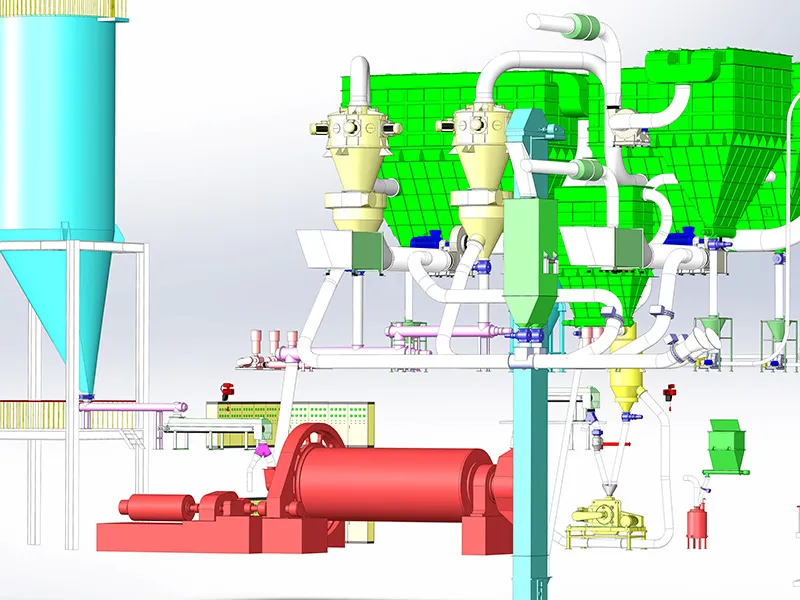
The process to make ultrafine powder is delicate and complex. It has three key steps: pretreating raw materials, ultrafine grinding, and graded collection. First, the raw material pretreatment stage is the basis of the whole process. It involves several processing steps, like crushing and screening the raw materials. This is to remove all impurities and unqualified particles. It ensures the smooth progress of subsequent processes. The work at this stage is crucial to ensure the quality of the final product.
Next is the ultrafine grinding stage. It is a key step in the production process. At this stage, we usually use ball mills and vertical mills to ultrafine grind the raw materials. They are advanced grinding machines. To get the best grinding effect, carefully control key parameters. These are the mill speed, the grinding body’s grade, and the mill’s temperature. Adjusting these parameters will directly improve grinding efficiency and product quality.
Finally, there is the graded collection stage. This stage’s main task is to grade the materials. It must collect ultrafine powders that meet specific requirements. The classifier’s grading accuracy and efficiency greatly affect ultrafine powder quality. The key to quality is to choose the right grading equipment. Also, optimize the grading process parameters.
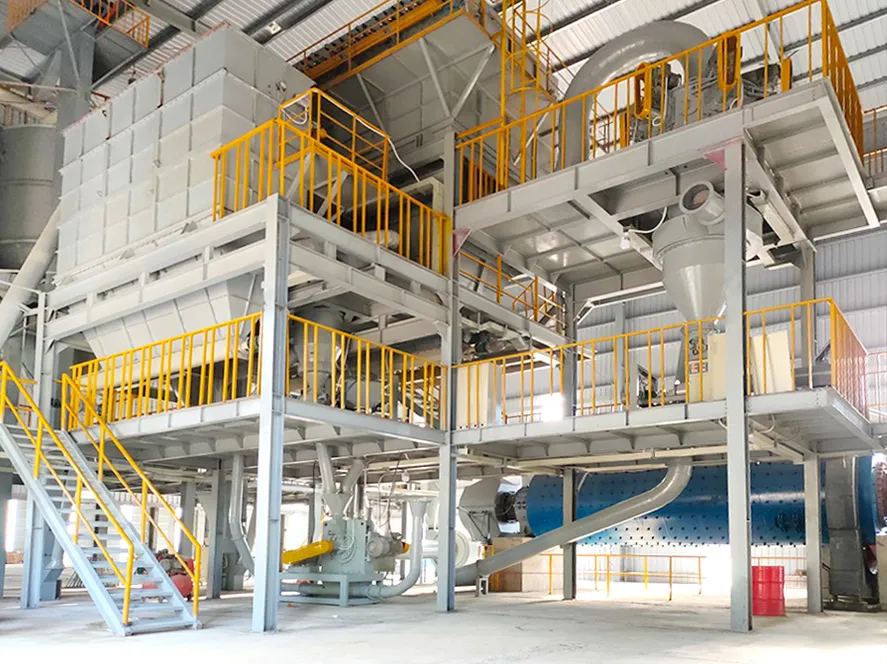
Demand and tech advances have made ultrafine grinding tech mature. A variety of efficient, energy-saving ultrafine grinders are now on the market. They can improve production efficiency, lower energy use, and lessen environmental impact.
The principle of gypsum as an activator
Gypsum is a common activator. It is vital to the hydration reaction of ultrafine powder. It can react with components, like aluminates, in ultrafine powders. This forms products, like ettringite, with higher hydration activity. These products greatly boost the reactivity of ultrafine powder. They also improve its dispersion in cement. Also, gypsum can adjust cement’s setting time. This improves concrete’s workability during construction. It also enhances its physical and mechanical properties after hardening. Gypsum boosts the dissolution and recrystallization of ultra-fine, powdered minerals, like aluminate. It forms a dense ettringite crystal network. This network structure creates more active sites for hydration reactions. It also increases the cement matrix’s density. This improves the material’s strength and durability.
To adjust cement’s setting time, add some gypsum. It will delay the initial setting time. It will improve the concrete’s fluidity and plasticity when poured and vibrated. This will aid construction. Gypsum can also speed up cement’s final setting. It helps the concrete gain strength in time to meet engineering requirements.
Also, adding gypsum improves the hardened properties of concrete. It can improve concrete’s microstructure. It can reduce pores and cracks. This improves its impermeability, freeze-thaw resistance, and durability. These improvements help concrete stay stable and safe in harsh environments. They extend the service life of engineering structures.
The amount of gypsum added and how to use it should be chosen based on the project’s needs and the materials’ traits. Excessive or improper addition may cause problems. It may cause slow cement setting, weak concrete, or poor performance. Thus, in practice, the added gypsum must be strictly controlled. It should be tested and optimized for specific engineering conditions.
Limitations of Specific Surface Area Measurement and Applications of Particle Size Analysis
Traditionally, specific surface area is a key indicator of ultrafine powders’ activity. In testing ultrafine powders, measuring specific surface area is common. This method has limits, especially for high-carbon ultrafine powders, like fly ash. Fly ash contains unburned carbon particles. They have many pores inside. This often leads to large errors in measuring specific surface area. So, using only the specific surface area to evaluate ultrafine powders may be wrong.
To evaluate ultrafine powder’s performance, particle size analysis is key. It provides a more accurate and thorough assessment. Particle size analysis can measure the particle size distribution of a powder. It includes key parameters like D10, D50 (median diameter), and D90. These parameters better reflect the powder’s particle characteristics. Particle size analysis can better control ultrafine powder’s size range. It can also optimize its dosage in concrete. This will greatly improve concrete’s overall performance. Also, particle size analysis can help us understand the powder’s uniformity. This is crucial to ensure stable and consistent concrete quality.
The application of ultrafine powder in concrete has significant importance and advantages. It can improve powder material gradation and increase concrete’s density and strength. It can also boost concrete’s performance by activating it and optimizing its particles. Using ultrafine powder saves energy, cuts emissions, and reduces carbon. In the future, science and technology will advance. As we focus on the environment, ultrafine powder will have more uses in concrete projects.
Summarize
Looking to the future, we need more research in a few areas. First, we need to study ultrafine powders’ chemical and physical properties. This will reveal their microscopic mechanisms in hydration reactions. Second, we should optimize the production process and equipment of ultrafine powders. This will improve efficiency and product quality. Third, we need to develop new activators and composite admixtures for ultrafine powders.
This will enhance concrete’s overall performance. Fourth, we should research using ultrafine powders in green buildings and sustainable development. We should promote their use in more fields. Ultrafine powders will be key in future concrete projects. They will help achieve green buildings and sustainable development.

